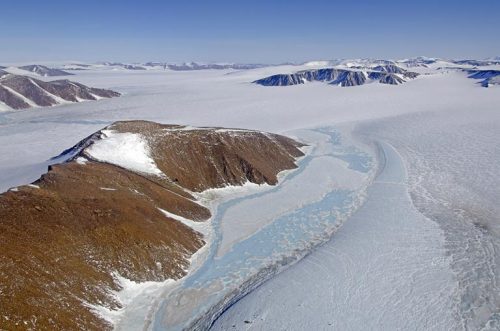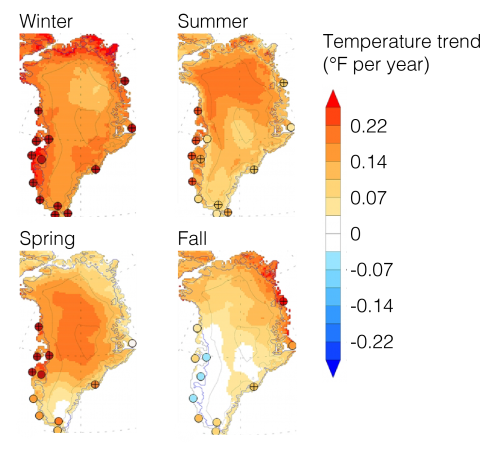Increased Greenland ice melt drives 21st-century sea level rise
August 17, 2020
Heather McFarland
907-474-6286
New analysis of almost 30 years’ of scientific data on Greenland’s melting ice sheet
predicts global sea level rise of at least 4 inches by the end of the 21st century, if climate warming trends continue.
The estimates, which scientists warn are “conservative,” are broadly consistent with
recent predictions reported by the Intergovernmental Panel on Climate Change.
The international study was led by researchers in the United Kingdom and includes
a climatologist from the University of Alaska Fairbanks. The findings are published
in the International Journal of Climatology.
The Greenland Ice Sheet is a giant reservoir of ice that contains enough water to
ultimately raise the global sea level by 23 feet.

The new study analyzed three decades of Greenland’s surface air temperature data, focusing mainly on coastal weather stations but also sites on the interior plateau of the ice sheet.
The researchers found that Greenland coastal regions warmed significantly, by about 7.9 degrees Fahrenheit in winter and 3.1 degrees in summer, from 1991 to 2019. For comparison, Alaska has warmed 5.6 degrees in winter during the same period.
Combining Greenland temperature data with computer model output of ice-sheet mass balance for 1972 to 2018 shows that each 1.8 degrees of summer warming corresponds to 116 billion tons per year of total mass loss from the ice sheet.
Using the latest global and regional climate modeling tools, the authors estimated that, under sustained strong global warming (a “business as usual” scenario), Greenland is likely to warm 7.2 to 11.9 degrees by the year 2100.
These recent and projected Greenland warmings are considerably greater than global temperature changes for equivalent time periods, reflecting the high sensitivity of polar regions to climate change.
“The Greenland Ice Sheet is one of the most sensitive and reliable measures of global climate change,” said lead author Edward Hanna, professor at the University of London.
The scientists used the relationship they derived between recent changes in Greenland summer temperature and ice sheet mass loss to predict a 3.9- to 4.9-inch rise in the global sea level by 2100.
“This has a global impact on sea level,” said co-author Tom Ballinger from UAF’s International Arctic Research Center. “It’s going to affect coastal communities and low-lying areas, whether they are in Alaska, the Lower 48 or globally.”

Ballinger contributed to the study by examining the relationship between Greenland air temperature changes and atmospheric circulation above the ice sheet. He noted strong and persistent high-pressure blocking over Greenland in summer 2019. This atmospheric phenomenon involves a greater-than-normal mass of air positioned over Greenland and tends to coincide with warm air flowing onto the ice sheet and a decrease in cloud cover.
The number of high-pressure blocking days in spring and summer has increased in recent decades. The authors show Greenland blocking played a crucial role in the near-record Greenland melt in the summer of 2019 (narrowly surpassed by the all-time record in 2012).
“There is a good chance that anomalous high-pressure blocking events will frequently occur in the future despite the fact that today’s global climate models don’t seem to indicate such,” explained Ballinger. “They’ve really struggled to pick up the frequency and magnitude of these historical blocking patterns and extremes.”
The authors emphasized that possible future changes in blocking need to be better considered in computer-model projections of climate change.
Other co-authors include John Cappelen, Xavier Fettweis, Sebastian Mernild, Thomas Mote, Ruth Mottram, Konrad Steffen, Richard Hall.
ADDITIONAL CONTACTS: Tom Ballinger, tjballinger@alaska.edu; Edward Hanna, EHanna@lincoln.ac.uk


